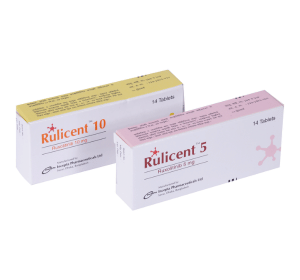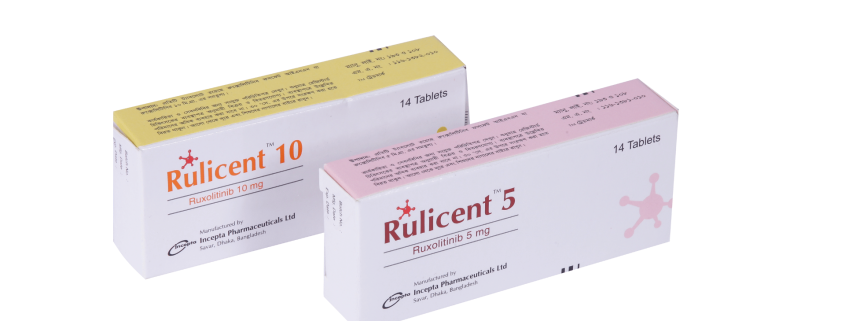Rulicent(Ruxolitinib)

Therapeutic Group: Anti Cancer
Presentation
Rulicent
TM 5: Each tablet contains Ruxolitinib Phosphate INN equivalent to Ruxolitinib 5 mg.
Rulicent
TM 10: Each tablet contains Ruxolitinib Phosphate INN equivalent to Ruxolitinib 10 mg.
Description
Ruxolitinib is an oral janus kinase (JAK) inhibitor. It contains JAK1 and JAK2 inhibitors which inhibit the signalling of cytokines (small cell-signalling protein molecules) and growth factor receptors that are dependant on JAK1 and JAK2 for signalling. Ruxolitinib restrains the growth of malignant cells and also controls cytokines that contribute to hypermetabolic state.
Indications
Ruxolitinib is a kinase inhibitor that is indicated for the treatment of:
• Intermediate or high-risk myelofibrosis, including primary myelofibrosis, post-polycythemia vera myelofibrosis and post-essential thrombocythemia myelofibrosis in adults.
• Polycythemia vera in adults who have had an inadequate response to or are intolerant of hydroxyurea.
• Steroid-refractory acute graft-versus-host disease in adult and pediatric patients 12 years and older
Dosage & Administration
Doses are individualized based on safety and efficacy. Starting doses per indication are noted below.
Myelofibrosis
• The starting dose of Ruxolitinib is based on patient’s baseline platelet count:
• Greater than 200 X 109 /L: 20 mg given orally twice daily
• 100 X 109 /L to 200 X 109 /L: 15 mg given orally twice daily
• 50 X 109 /L to less than 100 X 109 /L: 5 mg given orally twice daily
• Monitor complete blood counts every 2 to 4 weeks until doses are stabilized, and then as clinically indicated. Modify or interrupt dosing for thrombocytopenia. Hepatocellular carcinoma (HCC): 160 mg orally, once daily for the first 21 days of each 28-day cycle.
Polycythemia Vera
• The starting dose of Ruxolitinib is 10 mg given orally twice daily.
Acute Graft Versus Host Disease
• The starting dose of Ruxolitinib is 5 mg given orally twice daily
Side Effects
The most common hematologic adverse reactions (incidence > 20%) are thrombocytopenia and anemia and the most common nonhematologic adverse reactions (incidence >10%) are bruising, dizziness, headache, infections and edema.
Precautions
• Thrombocytopenia, Anemia and Neutropenia: Manage by dose reduction, or interruption, or transfusion.
• Risk of Infection: Assess patients for signs and symptoms of infection and initiate appropriate treatment promptly. Serious infections should have resolved before starting therapy with Ruxolitinib.
• Symptom Exacerbation Following Interruption or Discontinuation: Manage with supportive care and consider resuming treatment with Ruxolitinib.
• Risk of Non-Melanoma Skin Cancer: Perform periodic skin examinations.
• Lipid Elevations: Assess lipid levels 8-12 weeks from start of therapy and treat as needed.
Use in Pregnancy & Lactation
Ruxolitinib does not have any adequate and well-controlled studies in pregnant women. Thus the background risk of major birth defects and miscarriage for the indicated populations is unknown. Based on animal reproduction studies, Ruxolitinib was seen to cause adverse developmental outcomes during the period of organogenesis. Advice pregnant women or women with reproductive potential of the potential hazards of Ruxolitinib to the fetus.
There is no information regarding the presence of Ruxolitinib or its metabolites being excreted in human milk, the effects on the breast fed child, or the effects on milk production. Ruxolitinib and its metabolites were excreted in rat milk and because many drugs are present in human milk and because of the potential for thrombocytopenia and anemia shown for Ruxolitinib in human studies, breastfeeding must be discontinued during the treatment with Ruxolitinib and for two weeks after the final dose.
Drug Interaction
• Strong CYP3A4 Inhibitors or Fluconazole: Concomitant use of strong CYP3A4 inhibitors or Fluconazole with Ruxolitinib will increase the drug exposure. Reduce, interrupt, or discontinue Ruxolitinib doses with these drugs as recommended to prevent adverse effects due to over exposure to the drug. Avoid use of Ruxolitinib with fluconazole doses greater than 200 mg except in patients with acute graft versus host disease.
• Strong CYP3A4 Inducers: Concomitant use of strong CYP3A4 inducers with Ruxolitinib will decrease the drug exposure. No dose adjustment is necessary; however, monitor patients frequently and adjust the Ruxolitinib dose based on safety and efficacy.
Storage
Do not store above 30°C. Keep away from light and out of the reach of children.
Commercial Pack
Rulicent TM 5: Each box contains 2 alu-alu blister strips of 7 tablets.
Rulicent TM 10: Each box contains 2 alu-alu blister strips of 7 tablets.



